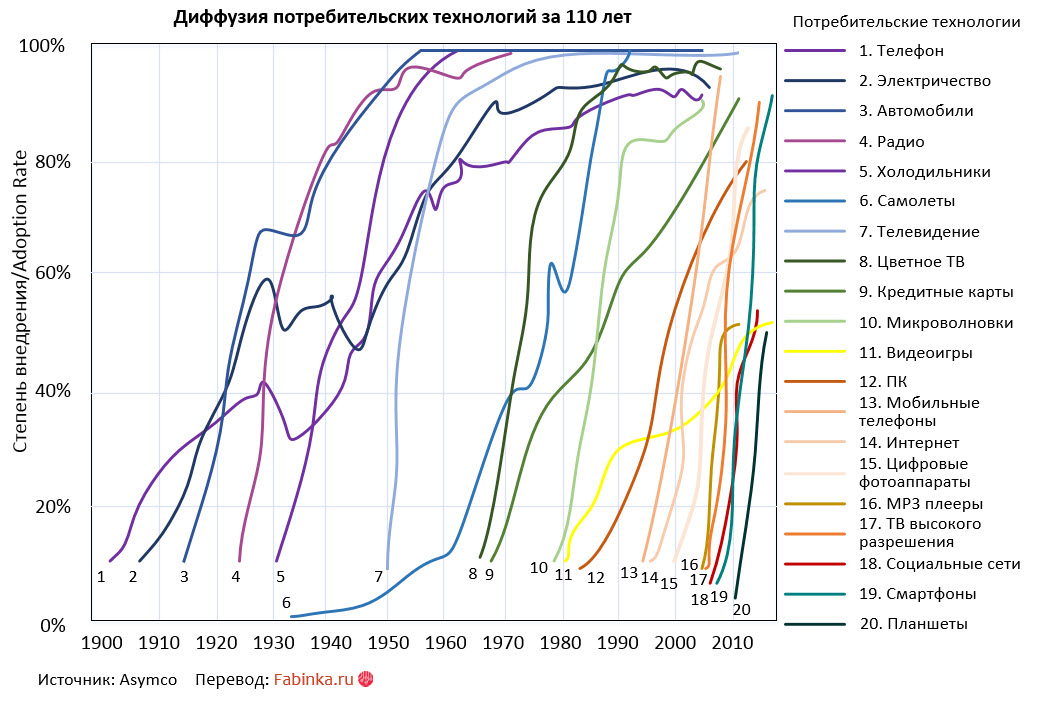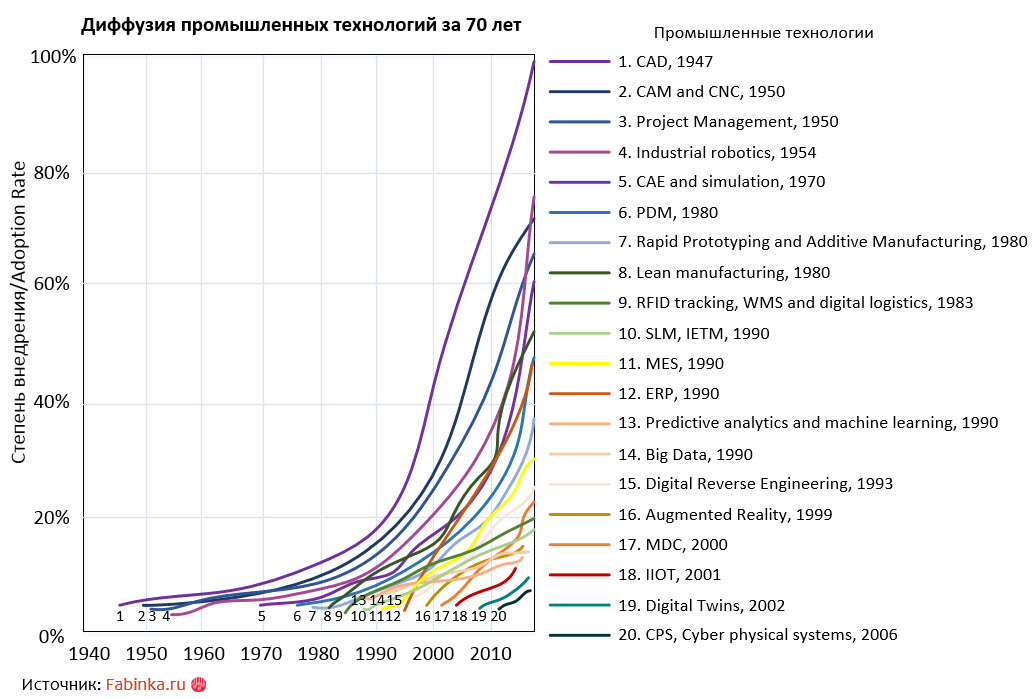Acceleration of technology diffusion and implications
March 1 in the blog of economists of the Bank of England sounded:
“In the global technological community, there are growing anxieties caused by a weak willingness of developed economies for the next industrial revolution. Its offensive could mean replacing millions of predominantly low-skilled workers, the collapse of many long-standing, but slowly adapting companies, a significant increase in the income gap of society and a growing industrial concentration associated with a sharp increase in a relatively small number of multinational technology corporations.

Economists, analyzing the course of previous industrial revolutions, note that not all of these risks occur. However, such an approach may underestimate the substantially different nature of the technological advances that are currently taking place, in the sense of their significantly greater industrial and professional values and the speed of their diffusion .
For this reason, it would be a mistake to reject the risks associated with these new technologies, recognizing them as insignificant . ”
')
Mauricio Armellini and Tim Pike, Bank Underground - Blog of the Bank of England (Bank of England)
Pay attention to the mention of changes in the diffusion rate of technology - the time for which they begin to be actively used by the majority of consumers (they are used by most of the fourth level, the late majority users in the Rogers consumer innovation diffusion model). Figure 1 shows the change in this rate over the past 110 years.

The key technology that increases the angles of inclination of the curves, making them almost vertical lines - the Internet. Consumers are getting faster and faster throughthe vanity vanity fairs , Shars and reposts, who are learning about the unique consumer characteristics of the products and want the same new gadget. On the other hand, the rate of integration of technologies in our lives is affected by the growth rate of the fall in their value (figure in the cap).
This, in turn, is greatly affected by the increase in the degree of automation of production and the acceleration of diffusion of production technologies (Figure 2).

The key question is: what will happen next?
And then the Bank of England economists in the quote above warn: neither in the case of distribution of pipelines and electrification in 1870, nor in the spread of automation in 1970 were there these super-fast J-shaped trajectories when technology was born — and over several years then industry and national economy). For the same few years, another company that has not managed to adapt and integrate technology into its daily activities, perishes. “Back in 2011, Foxconn representatives said that in the next 3-5 years, the company will replace 500,000 workers in China with 1 million robots. The process of large-scale automation began in March 2016, when 60,000 people were laid off at one of the factories, and 40,000 foxboats were equipped with several factories in the PRC. At the same time, it became known about Foxconn plans to increase the number of robotics by 20-30% annually. Such rates meet the standards for the development of robotics in China, which is among the three leaders in the implementation of industrial robots. ”
It’s all about the slope of the diffusion curve, say economists at the Bank of England — and attention to key technologies that change labor productivity, the quality of companies ’products and the speed of their introduction to the market as soon as possible.
It is all about the diffusion rate and the company's readiness to quickly integrate key technologies.
At the level of employees - it's all about the speed of their training. In fact, among other meanings, we see on the graphs of the learning curves of companies and teams of companies.
The one who quickly learned to use the new technology at minimal cost - he survived.
Welcome to life in the shape of the letter J. Who is not ready - disappears, C'est La Vie.
“In the global technological community, there are growing anxieties caused by a weak willingness of developed economies for the next industrial revolution. Its offensive could mean replacing millions of predominantly low-skilled workers, the collapse of many long-standing, but slowly adapting companies, a significant increase in the income gap of society and a growing industrial concentration associated with a sharp increase in a relatively small number of multinational technology corporations.

Economists, analyzing the course of previous industrial revolutions, note that not all of these risks occur. However, such an approach may underestimate the substantially different nature of the technological advances that are currently taking place, in the sense of their significantly greater industrial and professional values and the speed of their diffusion .
For this reason, it would be a mistake to reject the risks associated with these new technologies, recognizing them as insignificant . ”
')
Mauricio Armellini and Tim Pike, Bank Underground - Blog of the Bank of England (Bank of England)
Pay attention to the mention of changes in the diffusion rate of technology - the time for which they begin to be actively used by the majority of consumers (they are used by most of the fourth level, the late majority users in the Rogers consumer innovation diffusion model). Figure 1 shows the change in this rate over the past 110 years.

The key technology that increases the angles of inclination of the curves, making them almost vertical lines - the Internet. Consumers are getting faster and faster through
This, in turn, is greatly affected by the increase in the degree of automation of production and the acceleration of diffusion of production technologies (Figure 2).

The key question is: what will happen next?
And then the Bank of England economists in the quote above warn: neither in the case of distribution of pipelines and electrification in 1870, nor in the spread of automation in 1970 were there these super-fast J-shaped trajectories when technology was born — and over several years then industry and national economy). For the same few years, another company that has not managed to adapt and integrate technology into its daily activities, perishes. “Back in 2011, Foxconn representatives said that in the next 3-5 years, the company will replace 500,000 workers in China with 1 million robots. The process of large-scale automation began in March 2016, when 60,000 people were laid off at one of the factories, and 40,000 foxboats were equipped with several factories in the PRC. At the same time, it became known about Foxconn plans to increase the number of robotics by 20-30% annually. Such rates meet the standards for the development of robotics in China, which is among the three leaders in the implementation of industrial robots. ”
It’s all about the slope of the diffusion curve, say economists at the Bank of England — and attention to key technologies that change labor productivity, the quality of companies ’products and the speed of their introduction to the market as soon as possible.
It is all about the diffusion rate and the company's readiness to quickly integrate key technologies.
At the level of employees - it's all about the speed of their training. In fact, among other meanings, we see on the graphs of the learning curves of companies and teams of companies.
The one who quickly learned to use the new technology at minimal cost - he survived.
Welcome to life in the shape of the letter J. Who is not ready - disappears, C'est La Vie.
Source: https://habr.com/ru/post/373271/
All Articles